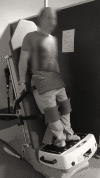Effects of Whole-Body Vibration-Assisted Training on Lower Limb Blood Flow in Children With Myelomeningocele
- PMID: 33644013
- PMCID: PMC7902517
- DOI: 10.3389/fbioe.2021.601747
Effects of Whole-Body Vibration-Assisted Training on Lower Limb Blood Flow in Children With Myelomeningocele
Abstract
This study investigated the effectiveness of whole-body vibration (WBV) training incorporated into a conventional physiotherapy (PT) program (WBV-assisted training) in improving blood flow in the lower limbs and range of motion in the lower limb joints of children with myelomeningocele (MMC). A total of 31 children with MMC (7-15 years old) underwent a 6 weeks treatment program consisting of 2 weeks of conventional PT followed by 4 weeks of WBV-assisted training. The assessment comprised two parts: evaluation of lower limb joint range of motion and Doppler ultrasonography of the superficial femoral, popliteal, and anterior tibial arteries and was performed three times for each of the participants (at baseline, after 10 sessions of PT but before WBV-assisted training, and after 20 sessions of WBV-assisted training). Our results showed that WBV-assisted training significantly improved lower limb circulation in patients with MMC, increasing velocity and reducing resistivity in all tested arteries. Moreover, WBV-assisted training alleviated lower-extremity contractures, especially of the knee. Thus, WBV-assisted training is effective as an adjunctive rehabilitation program for improving functional mobility in children with MMC.
Keywords: doppler ultrasound test; lower limb; myelomeningocele; range of motion; spina bifida; whole-body vibration.
Copyright © 2021 Szopa, Domagalska-Szopa, Siwiec and Kwiecień-Czerwieniec.
Conflict of interest statement
The authors declare that the research was conducted in the absence of any commercial or financial relationships that could be construed as a potential conflict of interest.
Figures
Similar articles
-
Effects of Whole-Body Vibration Training on Lower Limb Blood Flow in Children with Myelomeningocele-A Randomized Trial.J Clin Med. 2021 Sep 21;10(18):4273. doi: 10.3390/jcm10184273. J Clin Med. 2021. PMID: 34575386 Free PMC article.
-
Whole body vibration versus conventional physiotherapy to improve balance and gait in Parkinson's disease.Arch Phys Med Rehabil. 2008 Mar;89(3):399-403. doi: 10.1016/j.apmr.2007.09.031. Arch Phys Med Rehabil. 2008. PMID: 18295614 Clinical Trial.
-
Effects of whole body vibration exercise on neuromuscular function for individuals with knee osteoarthritis: study protocol for a randomized controlled trial.Trials. 2017 Sep 20;18(1):437. doi: 10.1186/s13063-017-2170-6. Trials. 2017. PMID: 28931439 Free PMC article. Clinical Trial.
-
Long-Term Effects of Whole-Body Vibration on Human Gait: A Systematic Review and Meta-Analysis.Front Neurol. 2019 Jun 19;10:627. doi: 10.3389/fneur.2019.00627. eCollection 2019. Front Neurol. 2019. PMID: 31316447 Free PMC article.
-
Whole-body vibration in children with disabilities demonstrates therapeutic potentials for pediatric cancer populations: a systematic review.Support Care Cancer. 2019 Feb;27(2):395-406. doi: 10.1007/s00520-018-4506-5. Epub 2018 Oct 27. Support Care Cancer. 2019. PMID: 30368670
Cited by
-
Effects of low-frequency vibration training on walking ability and body composition among older adults: a randomized controlled trial.PeerJ. 2025 Apr 16;13:e19263. doi: 10.7717/peerj.19263. eCollection 2025. PeerJ. 2025. PMID: 40256731 Free PMC article. Clinical Trial.
-
Effects of Whole-Body Vibration Training on Lower Limb Blood Flow in Children with Myelomeningocele-A Randomized Trial.J Clin Med. 2021 Sep 21;10(18):4273. doi: 10.3390/jcm10184273. J Clin Med. 2021. PMID: 34575386 Free PMC article.
References
-
- Altman D. G. (1991). Practical Statistics for Medical Research. London: Chapman and Hall/CRC.
-
- Apkon S. D., Fenton L., Coll J. R. (2008). Bone density in children with myelomeningocele. Dev. Med. Child Neurol. 51 63–67. - PubMed
-
- Boot C. R., van Langen H., Hopman M. T. (2003). Arterial vascular properties in individuals with spina bifida. Spinal Cord. 41 242–246. - PubMed
-
- Buffart L. M., Roebroeck M. E., Rol M., Stam H. J., van den Berg-Emons R. J. (2008a). Triad of physical activity, aerobic fitness and obesity in adolescents and young adults with myelomeningocele. J. Rehabil. Med. 40 70–75. - PubMed
-
- Buffart L. M., van den Berg-Emons R. J., Burdorf A., Janssen W. G., Stam H. J., Roebroeck M. E. (2008b). Cardiovascular disease risk factors and the relationships with physical activity, aerobic fitness, and body fat in adolescents and young adults with myelomeningocele. Arch. Phys. Med. Rehabil. 89 2167–2173. 10.1016/j.apmr.2008.04.015 - DOI - PubMed
LinkOut - more resources
Full Text Sources
Other Literature Sources


